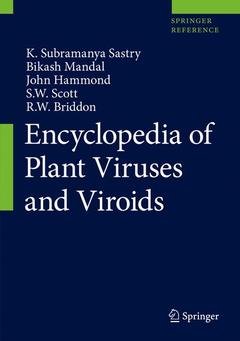Description
Encyclopedia of Plant Viruses and Viroids, 1st ed. 2019
Authors: Sastry K. Subramanya, Mandal Bikash, Hammond John, Scott S.W., Briddon R.W.
Language: English
Subject for Encyclopedia of Plant Viruses and Viroids:
Keywords
Description of Plant Virus; Phytopathogen; Plant Viruses; Serology; Viroids
1054.99 €
In Print (Delivery period: 15 days).
Add to cart2936 p. · 17.8x25.4 cm · Hardback
Description
/li>Contents
/li>Biography
/li>Comment
/li>
The Encyclopedia of Plant Viruses and Viroids provides an up-to-date information on the viruses and viroids infecting all types of cultivated and weed plants at global level; and is unique among plant virology texts as it is organized alphabetically by the genus name of the host plant infected. It allows the reader to readily determine all of the different viruses currently reported naturally infecting the plant genus and species. Information is provided for each virus and viroids on common synonyms, current taxonomic status, geographical distribution, symptoms induced, other known hosts, means of transmission and properties of both the virus particles and the genome. Where ever the same virus is known to infect multiple hosts, host-specific information, biological properties and genome characters are presented under each host affected. The index can be utilized to identify other crops infected by the same virus, showing which other crops might be at risk of infection in the event of introduction of a virus that has not previously reported in an area, or which might serve as potential virus reservoirs for infection of more sensitive or economically important crops than the host in which it is initially identified.
The taxonomy and nomenclature of the viruses and viroids are followed based on the current guidelines of the 10th ICTV Report, covering up to 2018 and also about many new viruses and viroids that have been reported but not yet recognized as species by ICTV, have been included in this Encyclopedia. The uniqueness of this Encyclopedia is that all the known viruses and viroids affecting more than 1010 plant species at global level are described and the plant species are arranged in alphabetical order of the scientific name of the plant along the relevant information on 1518 viruses and viroids and is the ready-reckoner of the global plant species and their viruses and viroids for students, scientists, teachers of Plant Pathology& Virology; and also for the crop protection professionals, agricultural policymakers, seed companies and quarantine agencies.
Abelia.- Allamanda cathartica.- Arabidopsis thaliana - Axonopus compressus.- Bambus.- Begonia.- Blainvillea rhomoboidea.- Buxus sempervirens.- Cajanus cajan.- Chamaescilla corymbosa.- Clarkia amoena.- Cucumis anguria.- Dactylis glomerata.- Dianthus amurensis.- Dracaena.- Duranta.- Ecballium elaterium.- Elettaria Cardamomum.- Eragrostis.- Exacum.- Fagus sylvatica.- Ficus carica.- Forsythia.- Fuchsia.- Gaillardia.- Gladiolus.- Gompholobium preissii.- Guizotia abyssinica.- Habenaria radiata.- Hibbertia.- Holcus lanatus.- Humulus japonicus.- Iberis semperflorens.- Ilex crenata.- Ipomoea batatas .- Ixora.- Jacquemontia.- Jasminum.- Jatropha .- Juglans regia.- Kalanchoe blossfeldiana.- Kalimeris indica.- Kennedia.- Kohleria.- Lablab purpureus.- Liatris spicata.- Lobelia.- Ludwigia.- Maclura pomifera.- Mentha.- Molinia coerulea.- Musa.- Nandina domestica.- Nerine.- Nicotiana tabacum .- Nothoscordum.- Ocimum.- Olea europaea .- Opuntia.- Oxalis.- Pachycladon.- Pelargonium.- Polygonum.- Pulmonaria.- Quercus marilandica.- Ranunculus asiaticus.- Ribes.- Robinia pseudoacacia.- Rubus .- Saccharum officinarum.- Sida.- Solanum lycopersicum.- Sutera cordata.- Tagetes.- Tecoma capensis.- Torenia.- Tulipa.- Ullucus tuberosus.- Unxia kubitzkii .- Urochloa Urtica.- Vaccinium angustifolium.- Verbena.- Vitis vinifera.- Voandzeia subterranea.- Wahlenbergia marginata.- Weigela florida.- Wissadula.- Wisteria.- Xanthium occidentale.- Xerochrysum bracteatum.- Yucca.- Zamia furfuracea.- Zea mays.- Zinnia.
Dr. K. Subramanya Sastry is currently retired and has last worked as Principal Scientist (ICAR), National Research Centre for Sorghum, Rajendranagar, Hyderabad from 1991 to 1998. His areas of interest are teaching and research in plant Virology, pathology, Microbiology. He has total 27 years of extension experience in Indian council of Agricultural Research and 5 years of teaching experience in Department of Botany, S.V. University, Tirupati. He has published total of 5 books and 83 research papers. Published three books on plant virology from Springer during 2012-14.
Dr. Bikash Mandal is currently working as Principal Scientist in Advanced Center for Plant Virology, Indian Agricultural Research Institute (IARI), New Delhi. His research and teaching area is Plant Virology. He has total 153 publications that includes 2 books, 8 book chapters, 72 research papers, 5 popular technical articles, 65 conference abstracts. He is the editor-in-Chief of Journal ‘VirusDisease’ (Springer) and VirusResearch news (Newsletter).
Dr. John Hammond is currently working as Research Plant Pathologist, United States Department of Agriculture, Agricultural Research Service, Floral and Nursery Plants Research Unit, Beltsville. His major areas of research are viruses affecting ornamental crops, with emphasis on potyvirus, potexvirus and carlavirus detection, differentiation, and methods of introducing resistance, use of transgenic plants to examine virus resistance and infectious viral clones to determine factors affecting host range, symptom induction, and systemic movement, and development of microarrays for plant virus detection and identification.
Dr. Simon W. Scott has recently retired from Clemson University as a Professor Emeritus in Plant Pathology. His major areas of research were viruses and virus-like agents affecting woody deciduous species with an emphasis on those viruses that affect the dominant fruit crop in SouthCaroli




